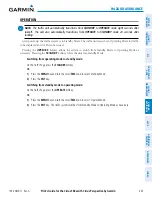
Pilot’s Guide for the Cirrus SR2x with Cirrus Perspective by Garmin
190-00820-11 Rev. A
464
HAZARD AVOIDANCE
SY
STEM
O
VER
VIEW
FLIGHT
INSTRUMENTS
EIS
AUDIO P
ANEL
& CNS
FLIGHT
MANA
GEMENT
HAZARD
AV
OID
ANCE
AFCS
ADDITIONAL FEA
TURES
APPENDICES
INDEX
DISPLAYING TRAFFIC INFORMATION
Traffic information is displayed on the following maps:
• PFD Inset Map
• Navigation Map Page
• Traffic Map Page
• Trip Planning Page
• Nearest Pages
• Active Flight Plan Page
• AUX - Video Page
Traffic information can also be displayed on the PFD when the Synthetic Vision Technology (SVT) system
option is installed and enabled. See the Additional Features Section for details.
Displaying traffic on the Traffic Map Page:
1)
Turn the large
FMS
Knob to select the Map Page Group.
2)
Turn the small
FMS
Knob to select the Traffic Map Page.
3)
Turn the
Joystick
clockwise to display a larger area or counter-clockwise to display a smaller area.
Figure 6-181 Traffic Map Page
Traffic
Mode
Altitude
Mode
Non-Threat
Traffic, 2500’
Above,
Descending
Proximity Traffic,
900’ Above,
Level
“No Bearing”
Traffic (Bearing
Undetermined),
Distance 4.0
nm, 500’ Above,
Descending
Traffic
Advisory Off-
Scale, 400’
Below, Level
Traffic Display
Range
Traffic Advisory,
500’ Below,
Climbing
Non-Threat
Traffic,
Altitude Not
Reported
The Traffic Map Page shows surrounding TAS traffic data in relation to the aircraft’s current position and
altitude, without basemap clutter. Aircraft orientation is always heading up unless there is no valid heading.
Map range is adjustable with the
Joystick
from 2 to 24 nm, as indicated by the map range rings.
The traffic mode and altitude display mode are annunciated in the upper left corner.






































